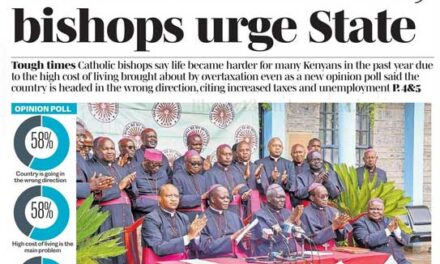
| Heading | Subtopics |
| Introduction | Overview of the educational crisis under Kenya Kwanza, Importance of addressing these issues, Scope of the article |
| Junior High School Crisis | Lack of resources in junior high schools, Absence of textbooks and teachers, Impact on students’ learning and development |
| Reduction in Secondary Education Funding | Comparison of capitation during Uhuru Kenyatta’s and Ruto’s regimes, Consequences of reduced funding, Partial disbursement issues |
| University Funding Model Issues | Introduction of the new funding model, Impact on access to university education, Socioeconomic disparities in higher education |
| Impact on Career Choices | Students are forced to choose affordable courses, Inequality in access to prestigious careers, and Long-term societal implications. |
| Education as an Equalizer | The role of education in promoting equality, How current policies undermine this role, Examples of affected students and families |
| Socioeconomic Divide in Education | Increasing gap between rich and poor students, Case studies of affected students, Potential long-term effects on Kenyan society |
| Policy Recommendations | Immediate steps to address the crisis, Long-term strategies for sustainable education funding, The role of government and stakeholders |
| Conclusion | Summary of key issues, Call to action for policymakers and the public, Final thoughts on the importance of equitable education |
| FAQs | Common questions about the education crisis, Practical advice for affected students and parents, Addressing common misconceptions |
Introduction
The education system in Kenya is facing a significant crisis under the Kenya Kwanza regime. The issues range from the lack of resources in junior high schools to drastic reductions in funding for secondary education and a problematic university funding model. These challenges are transforming education from an equalizer in society to a privilege for the wealthy. This article delves into the key problems, their impacts, and potential solutions to address this pressing crisis.
Junior High School Crisis
The current state of junior high schools in Kenya is alarming. Students are suffering due to the absence of essential resources and infrastructure.
Lack of Resources in Junior High Schools: Many junior high schools are operating without basic textbooks, adequate teachers, and necessary equipment. This severe lack of resources hampers the learning process and overall development of students.
Absence of Textbooks and Teachers: The shortage of textbooks means that students do not have access to the curriculum content they need. Additionally, the insufficient number of qualified teachers exacerbates the problem, leading to larger class sizes and less personalized attention for each student.
Impact on Students’ Learning and Development: The combined effect of these deficiencies is a significant drop in the quality of education. Students are not receiving the foundational knowledge and skills they need to progress, which will have long-term consequences on their academic and professional futures.
Reduction in Secondary Education Funding
The reduction in funding for secondary education under President William Ruto’s administration is another critical issue.
Comparison of Capitation During Uhuru Kenyatta’s and Ruto’s Regimes: During Uhuru Kenyatta’s presidency, the government provided a capitation of Ksh.22,200 per student to public high schools. Under Ruto, this amount has been reduced to Ksh.15,000, with reports indicating that even this reduced amount is not fully disbursed.
Consequences of Reduced Funding: This significant reduction in funding has led to deteriorating school infrastructure, a lack of learning materials, and the inability to retain qualified teachers. Schools are struggling to meet basic operational costs, negatively affecting the overall educational environment.
Partial Disbursement Issues: The inconsistency in disbursing the allocated funds further complicates the situation. Schools cannot plan effectively, leading to uncertainty and instability in the education system.
University Funding Model Issues
The new university funding model introduced by the Kenya Kwanza regime has made higher education less accessible, particularly for students from low-income backgrounds.
Introduction of the New Funding Model: The model has shifted the financial burden to students and their families, requiring them to cover a larger portion of their tuition and fees.
Impact on Access to University Education: This change has resulted in many students accumulating significant fee balances, making it difficult for them to continue their studies. The financial strain is forcing students to drop out or take on unsustainable levels of debt.
Socioeconomic Disparities in Higher Education: The funding model disproportionately affects students from low-income families, who now face greater barriers to accessing higher education. Prestigious and high-cost courses are increasingly becoming the preserve of the wealthy, undermining the principle of equal opportunity.
Impact on Career Choices
The current policies are forcing students to make career choices based on affordability rather than aptitude and interest.
Students Forced to Choose Affordable Courses: Many students are opting for less costly courses like education over more expensive ones like medicine, law, and engineering, regardless of their qualifications or interests.
Inequality in Access to Prestigious Careers: This trend exacerbates socioeconomic disparities, as only children from wealthy families can afford to pursue prestigious and lucrative careers. The lack of financial support limits the potential of talented students from less affluent backgrounds.
Long-term Societal Implications: The skewed access to higher education and professional careers will likely result in a less diverse workforce and perpetuate social inequalities. The country risks losing out on the contributions of bright students who are unable to realize their full potential.
Education as an Equalizer
Historically, education has been a powerful tool for promoting social equality. The current situation threatens this role.
The Role of Education in Promoting Equality: Education provides individuals with the skills and knowledge needed to improve their socioeconomic status. It has been a critical pathway for lifting people out of poverty and fostering social mobility.
How Current Policies Undermine This Role: The reduction in funding and changes in the university funding model are reversing the progress made in making education accessible to all. Instead of leveling the playing field, education is becoming a privilege for the wealthy.
Examples of Affected Students and Families: Numerous families are struggling to keep their children in school, and students with the potential for high academic achievement are being forced to abandon their dreams due to financial constraints.
Socioeconomic Divide in Education
The current educational policies are widening the gap between rich and poor students, with severe implications for societal cohesion and economic development.
Increasing Gap Between Rich and Poor Students: The disparities in access to quality education are growing, as wealthy families can afford better educational opportunities for their children, while poorer families cannot.
Case Studies of Affected Students: Stories from affected students highlight the challenges they face in accessing quality education. These case studies illustrate the broader impact of current policies on individual lives and communities.
Potential Long-term Effects on Kenyan Society: The widening educational divide could lead to increased social tensions and a less cohesive society. It may also hamper economic development by limiting the pool of skilled workers.
Policy Recommendations
Addressing the crisis in Kenya’s education system requires immediate and long-term strategies.
Immediate Steps to Address the Crisis: Increase funding for both primary and secondary education, ensure full and timely disbursement of allocated funds, and provide essential resources like textbooks and qualified teachers.
Long-term Strategies for Sustainable Education Funding: Develop a sustainable funding model that ensures equitable access to education. This could include progressive taxation to fund education and increased investment in public education infrastructure.
The Role of Government and Stakeholders: The government, private sector, and civil society must collaborate to address the educational crisis. Stakeholders should advocate for policies that prioritize education and hold the government accountable for its commitments.
Conclusion
The collapse of education under the Kenya Kwanza regime is a pressing issue that requires immediate action. By addressing funding shortfalls, revising the university funding model, and ensuring equitable access to education, Kenya can reclaim education as a powerful equalizer in society. Policymakers, educators, and the public must work together to ensure that every child has the opportunity to succeed, regardless of their socioeconomic background.
FAQs
What are the main issues facing education under the Kenya Kwanza regime?
Key issues include lack of resources in junior high schools, reduced funding for secondary education, and a new university funding model that disproportionately affects low-income students.
How has the reduction in secondary education funding affected schools?
Schools are struggling with inadequate resources, larger class sizes, and the inability to retain qualified teachers, leading to a decline in the quality of education.
What impact does the new university funding model have on students?
The model has made higher education less accessible, forcing students to choose courses based on affordability rather than aptitude, and increasing the financial burden on low-income families.
What can be done to address the education crisis in Kenya?
Immediate steps include increasing funding, ensuring timely disbursement of funds, and providing necessary resources. Long-term strategies involve developing a sustainable funding model and fostering collaboration among stakeholders.
How does the current situation affect the role of education as an equalizer?
Current policies are undermining education’s role as an equalizer by making it a privilege for the wealthy, thus widening socioeconomic disparities and limiting opportunities for low-income students.


